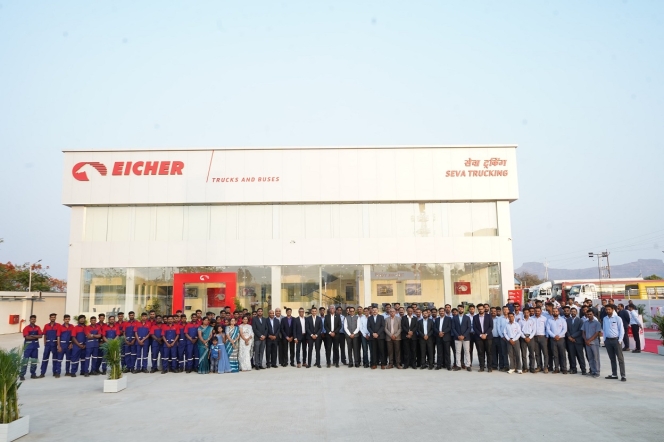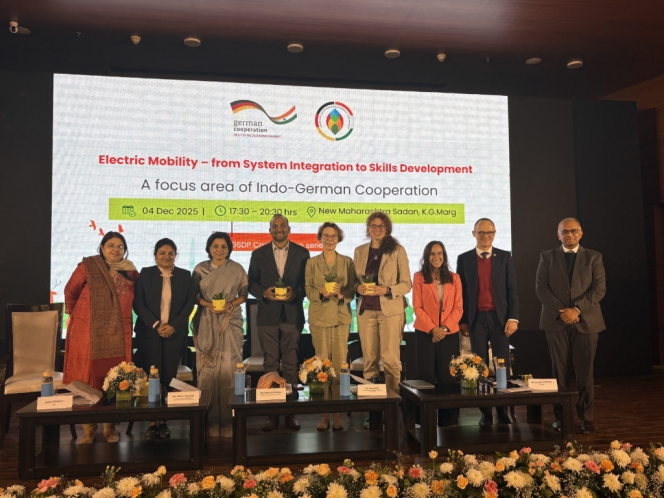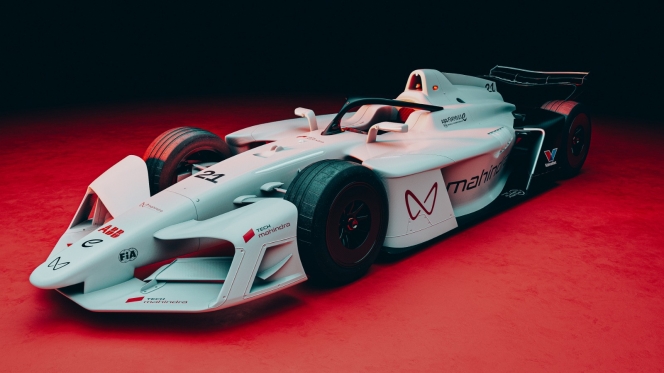VE Commercial Vehicles Digitalisation Drive Offers Smart Gains For Customers
- By Nilesh Wadhwa
- September 04, 2025

The Gurgaon-headquartered commercial vehicle major looks beyond just selling trucks and buses. The company’s focus on digitalisation and aftersales, it believes, is what the new-age customers need.
In the high-stakes world of commercial transportation, time is money – quite literally. Every hour a truck is off the road can mean missed deliveries, idle drivers, delayed shipments and unhappy customers. In India’s competitive commercial vehicle (CV) industry, the ability to minimise downtime and maximise uptime has become a critical differentiator for automakers.
For VE Commercial Vehicles, this principle has been elevated into a business philosophy. Over the past few years, the company has invested heavily in digital tools, predictive maintenance capabilities and an expanded service footprint to ensure that customers’ vehicles are running at peak performance for as many hours of the year as possible.
In an exclusive interaction with Motoring Trends, Ramesh Rajagopalan, EVP - Customer Service, Retail Excellence & Network Development, at VECV, shared his team’s work spans a network of over a thousand service points, a nationwide telematics backbone and a growing portfolio of uptime initiatives that integrate technology, training and process discipline.
Building a network
VECV’s current footprint exceeds 1,100 outlets across India, with an average of 10–12 new additions each month. This network covers the full range of commercial vehicles – from heavy-duty trucks and buses to light and small commercial vehicles.
The company’s growth is not limited to conventional CV outlets. The small commercial vehicle (SCV) network, particularly for electric models, is being built almost from scratch.
 Rajagopalan revealed that the company is “working towards creating a network of exclusive dealerships for the newly launched Eicher Pro X, designed to deliver a premium, digitally enabled customer experience. These born-digital outlets will function as one-stop destinations offering advanced product customisation, EV-ready infrastructure and seamless access to connected services. With a focus on uptime, personalisation and convenience, the Pro X dealerships will redefine commercial vehicle retail by offering a car-like, modern environment tailored to the evolving needs of today’s fleet operators.”
Rajagopalan revealed that the company is “working towards creating a network of exclusive dealerships for the newly launched Eicher Pro X, designed to deliver a premium, digitally enabled customer experience. These born-digital outlets will function as one-stop destinations offering advanced product customisation, EV-ready infrastructure and seamless access to connected services. With a focus on uptime, personalisation and convenience, the Pro X dealerships will redefine commercial vehicle retail by offering a car-like, modern environment tailored to the evolving needs of today’s fleet operators.”
“The starting point for us was to identify where we’re missing out – the ‘white spots’, where customers are already buying trucks and buses, but we aren’t present. The East and Northeast were clear gaps. We also looked at the service side: customers expect to have the nearest touchpoint for any service need, parts availability anywhere and 24x7 breakdown support,” he said.
These expectations are complicated by India’s rapidly evolving road infrastructure. With new expressways and freight corridors coming online, VECV has had to rethink its physical network, sometimes relocating facilities, other times adding new ones to stay close to high-traffic routes.
Telematics as the backbone of service planning
The decision to equip 100 percent of VECV’s BS6 vehicles with telematics was a strategic move made early in the transition to the stricter emission norms. The company shared that the BS6 trucks are far more electronically complex, with multiple sensors feeding real-time data on performance, emissions and potential faults.
Rajagopalan explained, “In BS6, any sensor failure that risks an emissions breach triggers a limp-home mode. That’s standard globally. But it can disrupt a customer’s operations if not handled quickly. We saw early on that predictive algorithms could identify error-code patterns that lead to breakdowns, allowing us to intervene before the vehicle stops.”
One example is AdBlue misuse – diluting diesel exhaust fluid with water, which can cause the vehicle to derate. Through telematics, VECV can detect the signs and remotely guide drivers on corrective steps, often via a quick video call.
This predictive maintenance model categorises alerts into three groups:
- Stop Now – requiring immediate action to prevent damage.
- Do It Yourself – where drivers can resolve the issue with guided support.
- Visit Soon – logged into the system so any VECV workshop can address it at the next scheduled service.
Measuring each minute
Digitalisation doesn’t stop at the vehicle. Every VECV workshop uses tablets to track a vehicle from the moment it enters the workshop, through job card creation, repair start and completion, invoicing and gate-out. Customers can see their vehicle’s status in real-time on display boards.
This transparency is more than cosmetic; it drives accountability. Every morning, operational teams review any vehicle that missed its promised delivery time, escalating cases that need additional support.
A recent initiative even monitors waiting times before work begins. If a loaded truck sits for more than an hour, the central control centre calls the dealer to find out why and get it moving. “For our customers, every minute is money. We can’t afford bottlenecks,” revealed Rajagopalan.
Retention in telematics
A common challenge in connected services is renewal beyond the complimentary period. VECV includes two years of telematics subscription with every vehicle and has kept renewal costs at about INR 6,000 annually.
In the early days, renewal rates were low. But targeted engagement – including onboarding every customer on the My Eicher app at delivery, monthly operating review meetings with large fleets and customised reports – has pushed renewal rates among big operators to 80–85 percent.
For smaller operators, overall renewal rates are about 35 percent, but with over 350,000 connected vehicles on Indian roads, the base is significant. VECV also addresses multi-device fatigue – where customers were earlier forced to install separate tracking units for clients or state mandates, by offering API integration, allowing its data to feed into external systems and avoiding duplicate hardware.
Perhaps the most distinctive element of VECV’s service model is its Uptime Centre, located at the company’s manufacturing plant. This facility operates 24x7, staffed with technical experts who can remotely diagnose issues, advise on repairs and escalate complex cases to R&D or manufacturing engineers.
If a problem can’t be resolved remotely within a couple of hours, specialist engineers, or what the company calls ‘flying doctors’, are dispatched to the vehicle location. The Uptime Centre also monitors parts queries, workshop performance and telematics alerts, ensuring that field teams have expert backup at all times.
Parts availability
Downtime isn’t just about repairs, but it is also about parts. To address this, VECV has identified 250 high-demand parts and mandated that every workshop keeps them in stock. If any of these parts is unavailable and not supplied within 24 hours, it is provided free of charge.
This guarantee is part of a broader spare parts strategy that includes decentralised stocking, demand forecasting based on telematics data and close coordination between dealers and the central supply chain.
With trucks and buses running more kilometres per year than ever – e-commerce trucks and long-distance buses reaching 200,000 km annually – service demand is growing even as reliability and service intervals improve.
To meet this, VECV has:
- 70 workshops operating round-the-clock, 365 days a year.
- Nearly 300 workshops running extended hours or double shifts.
- Training programmes to upskill technicians for faster, more accurate repairs.
- Investments in better workshop tools and equipment to boost productivity.
Dealers as partners in performance
Rajagopalan believes dealer capability is as important as infrastructure: “Today’s customers don’t tolerate delays. Delivery commitments that were acceptable in a week are now expected in hours. That pressure flows through the entire supply chain.”
VECV has put process discipline and transparency at the core of dealer operations. Every dealer is connected to the central system, with KPIs on breakdown response time, parts availability and repair turnaround. These metrics are published internally, creating healthy competition among regions to be ‘best-in-class.’
Rajagopalan shared his five strategic priorities or key focus areas –
- Service Capacity Expansion – adding workshops, increasing working hours and boosting throughput per facility.
- Competency Development – continuous technician training for faster, first-time-right repairs.
- Parts Availability – maintaining high stock levels of critical components, backed by guarantees.
- Predictive Maintenance Evolution – extending analytics beyond sensor data to wear-and-tear parts like clutches and brakes.
- Telematics Insights – leveraging connected data for deeper operational recommendations to customers.
While much of VECV’s work is grounded in engineering and technology, Rajagopalan emphasises that the company’s philosophy is human-centred. “Our uptime promise is non-negotiable. Every innovation, whether digital or operational, is aimed at keeping our customers’ wheels turning. That’s how they earn and that’s how we build trust,” he said.
From a strategic perspective, VECV’s approach reflects an industry-wide shift. The CV market is no longer just about selling hardware; it’s about selling an ecosystem of services, digital capabilities and operational support – and backing it up with the speed and reliability that today’s logistics-driven economy demands.
Vingroup Announces $3 Billion Multi-Sector Investment In Telangana
- By MT Bureau
- December 09, 2025
Vietnam’s Vingroup has signed a strategic memorandum of understanding (MoU) with the Government of Telangana, outlining a comprehensive plan to develop a multi-sector ecosystem through a proposed phased investment of USD 3 billion. This expansive collaboration aims to drive socio-economic growth in the Indian state through major initiatives in smart urban development, electric mobility, healthcare, education, tourism and renewable energy.
The partnership’s most ambitious component is the planned creation of a large-scale smart city. This new urban area, designed to accommodate approximately 200,000 residents, will integrate sustainable planning principles with international-standard amenities and is expected to generate significant local employment. Supporting this community, Vingroup will develop essential social infrastructure, including international-grade multi-specialty hospitals and an integrated K-12 school system.
A key pillar of the initiative is establishing a sustainable electric mobility ecosystem. This involves launching India's first large-scale electric taxi service within Telangana, supported by a widespread network of charging stations. To ensure a green power supply for this fleet, urban areas and industrial zones, Vingroup further proposes to develop a substantial solar farm. The collaboration will also enhance Telangana’s tourism appeal through a dedicated complex featuring theme parks and wildlife attractions.
The Telangana government has committed to supporting these projects by facilitating land allocation, assisting with master planning and administrative procedures and mobilising the necessary connecting infrastructure. This foundational agreement not only marks a significant step in Vingroup’s international expansion but also strengthens economic and business ties between Vietnam and India, creating a framework for future cooperation and mutual growth.
A Revanth Reddy, Hon’ble Chief Minister, Government of Telangana, said, “The USD 3 billion investment by Vingroup is a massive vote of confidence in the ‘Telangana Rising’ vision, particularly our focus on sustainable urban development and green infrastructure. This is more than capital; it’s a partnership to build a futuristic, net-zero city and introduce India’s first large-scale electric taxi fleet, directly improving the quality of life for our citizens. Our government guarantees accelerated execution to ensure this global vision becomes a local reality.”
D Sridhar Babu, Hon'ble Industries Minister, Government of Telangana, said, "Vingroup's multi-sectoral commitment, spanning smart cities, solar power and advanced social infrastructure like hospitals and schools, demonstrates the stability and breadth of Telangana’s industrial policy. We are committed to translating this significant capital inflow into local opportunity, positioning Telangana as the gateway for Vietnamese and South-East Asian investment into India's fastest-growing economy."
Sanjay Kumar, IAS, Special Chief Secretary to the Government, Government of Telangana, said, “We welcome Vingroup’s presence in Telangana and recognise the achievements the Group has made in Vietnam, particularly in urban development, green infrastructure and electrified transportation. With the Group’s extensive expertise and capability to execute large-scale projects, we believe that this cooperation will mark an important step forward in shaping a modern and sustainable urban landscape and improving the quality of life for the people of Telangana.”
Pham Sanh Chau, CEO of Vingroup Asia and VinFast Asia, said, “Vingroup sees tremendous potential in Telangana and we aspire to build a long-term partnership with the state government. With our proven track record in delivering mega urban developments, large-scale infrastructure and a comprehensive electric mobility ecosystem, we believe that our collaboration with Telangana will generate tangible value, promote sustainable development and enhance the quality of life for local residents.”
- Indo-German Partnership for Green and Sustainable Development Goal
- Christine Toetzke
- Federal Ministry for Economic Cooperation and Development
India And Germany Discuss Electric Mobility Ecosystem Transformation
- By MT Bureau
- December 05, 2025

India and Germany convened a high-level roundtable under the Indo-German Partnership for Green and Sustainable Development (GSDP) to discuss solutions for advancing electric mobility ecosystems. The ninth edition of the GSDP Conversation Series focused on ‘Electric Mobility: From System Integration to Skills Development’.
The roundtable brought together senior officials from key central ministries, state and city administrations, public transport undertakings, distribution companies (DISCOMs), industry leaders and international partners to address the shift from fragmented pilots to a coordinated, ecosystem-wide transformation.
The discussion underlined that India can only achieve its electric mobility targets through integrated planning across various sectors, including renewable energy, transportation, manufacturing, finance and skills. Stronger coordination among the central government, states and cities was also noted as key to successful implementation.
The participants prioritised five key themes to shape the next phase of India’s e-mobility transition:
- Multimodal Electrification: Integrating metro, bus, shared mobility and last-mile services into a unified electric transport system.
- Charging Infrastructure and Grid Readiness: Enhancing coordination with DISCOMs, ensuring land and power capacity, standardising charging systems and strengthening battery safety and circularity.
- Financing and Procurement: Improving bankability, payment security, risk sharing, contract structures and financial instruments for e-buses and commercial EVs.
- Skills and Gender Inclusion: Addressing shortages in EV engineering, charger installation, battery management, safety and digital mobility services while expanding opportunities for women.
- Indo-German Collaboration: Advancing cooperation in areas such as grid management, multimodal planning, standardisation, battery circularity and vocational training.
Christine Toetzke, Director General for Asia, Latin America, Middle East & Eastern/Southeastern Europe, Federal Ministry for Economic Cooperation and Development (BMZ), Germany, said, “Germany and India share a long-standing partnership rooted in trust, ambition, and a shared vision for a greener future. The Green and Sustainable Development Partnership is central to our international engagement, reflecting our joint commitment to make development both climate-compatible and socially inclusive. Electric mobility is not merely a technological shift; it is a transformation of how our societies move, how we design our cities, and how we create opportunities for future generations. As India advances this transition at a remarkable scale and speed, Germany stands ready to support with system-level planning, vocational skills development and innovation in areas such as battery management and circular economy solutions. Our cooperation is a long-term investment in cleaner air, safer mobility, and more equitable access to opportunity for all.”
Senior officials emphasised the importance of aligning national schemes with local implementation capacity, noting that India now requires system-wide approaches that combine depot electrification, grid readiness, multimodal integration, transparent procurement models and a skilled workforce. The dialogue reaffirmed the commitment of both nations to accelerate clean, efficient and inclusive mobility solutions.
- Hagerty UK
- Vehicle Excise Duty Exemption
- VED Exemption
- Historic & Classic Vehicles Alliance
- Classic Cars
UK Chancellor Maintains Vehicle Excise Duty Exemption For Classic Cars
- By MT Bureau
- November 27, 2025

The UK's cherished classic car community can finally breathe a collective sigh of relief. The decisive action by Chancellor Rachel Reeves in the Autumn Budget to maintain the Vehicle Excise Duty (VED) exemption for vehicles over 40 years old has ended a prolonged period of uncertainty, securing a stable future for this vital sector. Mark Roper, Managing Director of Hagerty UK, welcomed this clarity, noting that the confirmed freeze on fuel duty further solidifies a supportive environment for owners. He underscores that this is a significant win for the GBP-7.3-billion industry that supports over 100,000 jobs and contributes GBP 3 billion annually to the UK economy, all while championing an inherently sustainable form of motoring.
This perspective on sustainability is reinforced by Dale Keller, CEO of the Historic & Classic Vehicles Alliance (HCVA), who affirms that the tax exemption logically aligns with environmental objectives. Classic vehicles, preserved as moving heritage, have a negligible lifecycle carbon footprint compared to new manufacturing and are driven infrequently. The original principle of the exemption remains valid, as applying a modern tax to these rarely used assets would be inequitable.
Alongside the VED news, the Chancellor confirmed the continuation of the MOT exemption for classic cars, though this will remain under review. On this point, Roper of Hagerty UK strikes a note of caution, observing that many within the industry advocate for an annual roadworthiness check. He notes that a great number of responsible classic owners voluntarily submit their vehicles for an MOT each year, valuing the independent assurance of safety and mechanical integrity it provides.
For Hagerty UK, as a specialist insurer deeply embedded in this world, the government’s affirmation is a powerful endorsement of the sector's cultural and economic value. Through its vibrant Clubhouse at Bicester Heritage and unique events like RADwood, Hagerty is actively fostering this passionate community. Similarly, the HCVA continues its mission to protect and promote the diverse ecosystem of specialists, restorers and businesses that form the backbone of this multi-billion-pound industry, ensuring its legacy for generations to come.
Mahindra Racing Extends Formula E Involvement With GEN4 Manufacturer Commitment
- By MT Bureau
- November 26, 2025

Mahindra Racing has solidified its long-term future in electric motorsport by confirming its manufacturer commitment to the GEN4 era of the ABB FIA Formula E World Championship, starting in 2026/27. This announcement, made during the unveiling of its new M12Electro race car in India, extends a relationship that began in 2013 when Mahindra stood as both a founding team and the first OEM to join the all-electric series.
The team's current trajectory underscores the significance of this pledge. Following a dramatic 18-month transformation under CEO and Team Principal Frederic Bertrand, Mahindra Racing has evolved from a backmarker into a consistent front-runner. This resurgence was powered by the redesigned M11Electro, in which drivers Nyck de Vries and Edoardo Mortara collectively secured five podium finishes in Season 11, catapulting the squad to a stellar fourth place in the world championship. The newly launched M12Electro is the intended vehicle to maintain this status as a top-five contender and a regular threat for podium positions in the forthcoming season.
The technical landscape for GEN4 promises to further electrify the sport. The next-generation cars will boast a peak race power of 450 kw, with a potent 600 kw available in ATTACK MODE to empower aggressive overtaking. Enhanced strategic possibilities will come from a race energy capacity of up to 55 kWh and a remarkable 700 kw of regenerative braking. In a continued commitment to sustainability, the GEN4 chassis will be produced from 100 percent recyclable materials and will feature two distinct aerodynamic configurations – high-downforce for qualifying and low-downforce for races – to optimise performance.
Mahindra's ambition is to leverage this new regulatory chapter to build on its renewed momentum, chase incremental gains and establish itself as a confirmed championship contender against elite manufacturers like Porsche and Jaguar. This competitive platform also serves a broader purpose, aligning with the Mahindra Group’s sustainability initiatives. The team, the first in Formula E to earn the FIA’s Three-Star Sustainability Accreditation, has embarked on its ‘Planet Positive’ programme. This initiative is dedicated to driving positive impact in communities and economies, accelerating climate solutions and using the intersection of sport and technology as a catalyst for a better future.
R Velusamy, Chairman, Mahindra Racing, said, "Mahindra Racing has always been a symbol of our commitment to the Race to Road journey – where cutting-edge innovation on the track directly shapes the clean, intelligent and high-performance mobility solutions we deliver to customers. Formula E is a powerful platform for innovating new technology, giving us the ability to experiment, learn and advance electric powertrain efficiency, sustainable materials and software intelligence. As we step into the GEN4 era, our ambition only grows stronger. Continuing this journey till 2030 is a testament to our belief in the sport, in electrification and in India’s role in leading global sustainable mobility. We are proud to champion this future, and GEN4 represents an exciting new chapter for Mahindra Racing and the Mahindra Group.”
Frederic Bertrand, Team Principal, Mahindra Racing, said, “I’m delighted to share this announcement that Mahindra Racing will remain in Formula E as a manufacturer for the GEN4 era. As a team, we have been on a fantastic journey over the past two seasons. What we have built and achieved as a group has been exceptional, and with this announcement, we now have the platform to keep growing and developing and achieve even greater success in the future. None of this would be possible without our colleagues across the Mahindra Group. They have bought into the project and the vision, and we will keep working hard to not only make India proud but also showcase exactly why it has the potential to be a major player on the world stage in the automotive and technology industries. Their enthusiasm to ‘Scream Electric’ is hugely inspiring to the whole team, and we will continue to represent them with pride in this next exciting chapter of our Formula E story in the coming years.”
Jeff Dodds, CEO, Formula E, said, “We’re thrilled to confirm Mahindra’s long-term commitment to the GEN4 era of the ABB FIA Formula E World Championship. As one of our founding teams, Mahindra has been with us since the very beginning, consistently championing electric racing and innovation. Their bold vision for sustainable mobility and continued investment in advanced EV technology perfectly align with Formula E’s mission. Mahindra’s enduring presence not only strengthens our position in a key market but also reinforces Formula E’s role as a global platform for driving positive change. We’re excited to see what they’ll achieve in this next chapter of performance and progress.”
Marek Nawarecki, Senior Circuit Sport Director, FIA, said, “Following the GEN4 reveal and the really positive sentiment reported, we are pleased to announce Mahindra as the sixth manufacturer to commit to Formula E’s GEN4 era. This is testament to the relevance of the road map we are implementing in Formula E for OEMs. GEN4 underscores just how far the ABB FIA Formula E World Championship has come since 2014 and we are looking forward to continuing this journey with Mahindra as one of the founding teams and partners.”





Comments (0)
ADD COMMENT